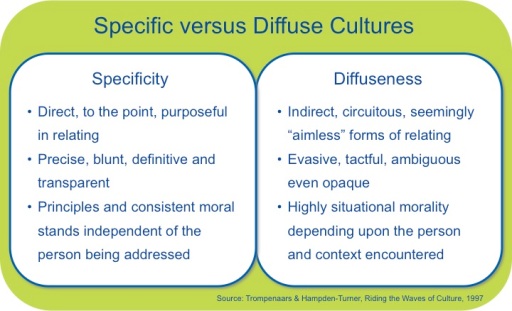Business leaders of multinational organizations are often confronted with cross-cultural differences. These differences can cause misunderstandings and awkward situations between people. Especially when people feel they are losing Face. Face – an Eastern concept most likened to the Western concept of respect and dignity. Making people feel they are losing Face occurs more easily than we might expect and can seriously damage relationships.
This cross-cultural aspect of ‘losing Face’ can for instance play a role when you are responsible for leading a complex change project involving people from other cultures.
Brian Cook meets with his Chinese change manager Chan Ling and his team at the Beijing office of a European corporation to discuss last month’s delay in the change deadlines. He questions Chan Ling repeatedly about his team’s underperformance. Brian openly states he believes the team is not pushing hard enough and that there is a lack of commitment. He stresses that Ling is accountable for the results of the team and that he should have informed him about the issues. Ling nods silently and keeps shuffling through the papers lying on the desk in front of him. Then he pulls back his chair, stands up, walks out of the room, and never returns. (Example with fictitious names)
Chan Ling feels he has lost Face. He perceives the directness of Brian’s approach as rude and insulting to him personally. In his culture Face is more important than any other thing. It is almost considered a physical entity, which can be ‘given’, ‘saved’, ‘enjoyed’, ‘considered’, or – and this is every Chinese’s nightmare – ‘lost’. The incident has seriously disturbed the relationship between him and Brian.
Ren yao lian, shu yao pi.
A person needs Face, like a tree needs bark.
(Chinese proverb)
The importance of keeping Face does not just exist in the Chinese culture. You experience it in many cultures around the world. It is related to what is described in literature as the difference between ‘low-context’ (e.g. US, Germany, Scandinavia, Holland) and ‘high-context’ cultures (e.g. China, Japan, Italy, Mexico, Brazil) (read more about low versus high-context cultures). Or as Trompenaars calls ‘specific’ cultures versus ‘diffuse’ cultures. People from low-context or specific cultures can unintentionally create situations, which people from diffuse-oriented cultures perceive as loss of Face. People from diffuse or high-context cultures can unintentionally create situations, which people from specific-oriented cultures perceive as not open or dishonest.

Now, why is it important to be aware of this cultural difference? Not because there is a good or bad side to it! Not because being direct is wrong and being indirect is by definition right. Not because being precise and transparent should always prevail over being cautious and evasive. Not because being open and blunt is always rude and insulting. Not because being silent is equal to being dishonest.
It is important to be sensitive to this cultural difference because it has a direct impact on the level of trust between each other! Because it can damage the relationship, and the collaboration! I vividly remember this discussion on a conference I attended not so long ago. At a certain moment during a panel discussion about cross-cultural relationships a British participant raised the question: “Do we not over-emphasize trust? Are we not making it too complex for ourselves?” A Chinese stood up and answered: “It depends on the quality of the relationship that you want.”
That is the essence: being direct or not, paying extra attention to the context or not, it all comes down to the quality of the relationship that you want. And this is not a one-way street. Sometimes being direct and assertive can be helpful, even be an example to others, and therefore strengthen the relationship. Sometimes a more listening and receptive attitude is what helps the relationship forward.
How can you improve the quality of cross-cultural relationships and avoid loss of Face in the teams you lead?
Be aware of low versus high-context cultural differences:
Pay extra attention to these differences. Observe carefully what happens during the meeting or conversation. Prepare yourself upfront, remember experiences from past meetings, talk with colleagues, and read about it.
Avoid ‘right versus wrong thinking’:
Focus on understanding what makes the behavior of the other different and why, not on what irritates you about it. Do not criticize, complain or condemn. Show respect for other opinions. Don’t say ‘you are wrong’. Say something like ‘I may be wrong. I frequently am. Let’s examine the facts.’
Adjust your communication style:
When ‘low-context’ meets ‘high-context’:
- Listen more than you speak
- Observe body language carefully
- Ask questions before you give an opinion
- Introduce your opinion in a way that adds value to the other
- Don’t force the other to give an opinion
- Show respect for hierarchy and age
- Pay attention to personal and family matters of the other
When ‘high-context’ meets ‘low-context’:
- Take what the other says at face value
- Speak up, be to the point
- Share your opinion when you have one
- Focus on tasks and facts
- Show your qualities and expertise to others
- Respect privacy
Use the difference in cultures as a strength:
Have an open mind and focus on how to reconcile the qualities of openness/transparency with those of patience/indirectness.
Written by Aad Boot and Hanneke Siebelink
If you want to receive upcoming LeadershipWatch articles and news in your mailbox, then simply register at the top of this page. Your personal information will be kept strictly confidential. Photo: jetheriot/Flickr (Creative Commons)Aad is a global leadership advisor, change leader, leadership team facilitator, executive coach, and frequently asked keynote speaker. He is founder and managing partner at HRS Business Transformation Services where he works with executives and leadership teams internationally on three key topics: ‘leading complex change’, ‘cross-cultural leadership’, and ‘post-merger integration’. Find out more about Aad and HRS’ services. If you would like to invite Aad to your organization feel free to contact him here.
Related articles
- Leadership: What is The Essence of Building Trust (leadershipwatch-aadboot.com)
- How Successful Cross-Cultural Leaders Work (leadershipwatch-aadboot.com)













Reblogged this on International Business Skills (Business English, Business Skills and Intercultural Communication) and commented:
“Saving Face” is a must have for any Cross-Cultural Leader.
LikeLike
Thanks, Christopher. Glad you enjoyed it.
LikeLike
I agree with the article. I have a friend who is currently a consultant and helping a company based in different countries to manage and eventually institutionalize an IT systems change. In the process of giving feedback to a Japanese client, my consultant friend used a more Western-type approach – straightforward, direct, objective presentation of what Jim Collins (author of Good to Great) would labeled as the “brutal facts which the Japanese executive had to confront in front of the management committee of which he was also a key figure.
From my friend’s point of view, she was being “sincere about laying the cards down to them” so that they could see thr “error of their ways” and be helped into correcting these defects.
From the Japanese executive’s point of view, “never expose my weakness to others”. He viewed it ad an affront, a sign of total disrespect and absence of positive regard. The Japanese stood up, walked out and never talked or interacted wth my firiend again.
Being cross-cultural savvy entails a strong sense of awareness and knowledge on how to conduct oneself in the presence of diverse cultures. It requires us to study and learn first aout their history, their sensitivities, what they would consider as business etiquette. We may sometimes forget this because we may be more focused on our job or goal, and forget we are deallng with the uniqueness of the individual before us, from a different culture with a set of their own beliefs and practices which may be opposite ours.
LikeLiked by 1 person
Karen, great story! It illustrates very well the importance of cross-cultural awareness. Thanks for sharing!
LikeLike
Always a pleasure to read your posts. Can you have a look on my last webdoc dedicated to China. I tried to to help the people understand chinese culture by turning their questioning from “how to do” to “why it is like that”. Unfortunately, it is in french … http://www.plongeeaucoeurdelachine.com
LikeLike
This becomes a real issue with short term assignments or placements. The Western person is sent for 3 – 12 months to another culture with no real training or understanding (except lonely planet) by the boss. They are there to get results and outcomes. To gain understanding of face and cultural differences takes time which the west is not brilliant at. To the ex-pat employee; it doesn’t matter if they burn people – they are home in a few months. They are not there to make friends. Of course, what I am saying is a generalisation but it is the mentality of what I have witnessed. Short term assignments can be very dangerous and less education and training is invested in employees who only do short term or several little short term trips a year etc than the longer term residential employees. A lot of cross cultural training is more geared towards the long term.
Face is a really interesting and enigmatic topic for us from the west. I remember years ago asking for directions in China and getting told to go the complete opposite direction as for them it was better to have an answer than no answer (as I found out later from a field worker.). Yet deep down I felt my values were crossed and that I was lied and deceived too.
I also find collective societies also really fascinating in the way they do business, make decisions,solve problems etc. Russia was eye opening for this.
LikeLike
Thanks, Pete. Very interesting point you make on expats and the challenge companies have in facilitating working environments where cross-cultural relationships can go deeper than simply ‘getting the job done’. Not just because it makes collaboration much more pleasant, but because it boosts the company’s success significantly.
LikeLike
Accepting leadership in cross cultural workplace is indeed a challenging task with many aspects like communication,understanding cultural strengths involved. Eastern and Western cultures have different cultural aspects and differ a lot in the work-culture, so it becomes essential to understand both cultures when working with them simultaneously.
LikeLike
I couldn’t agree more with your statement. A crucial competence for today’s leaders to develop. Thanks!
LikeLike
Pingback: Concept of ‘losing face’ – simply an eastern concept? « ETAS learning technologies
Reblogged this on kwalitisme.
LikeLike
Pingback: Post Merger Integration: Cultural Alignment is a Prerequisite for Value Creation | LeadershipWatch
Pingback: A Toast to My Liberal Arts Degree | Nicolle Merrill
Pingback: 4 Tips to Make Your Team Embrace Accountability - Rockstar Managers